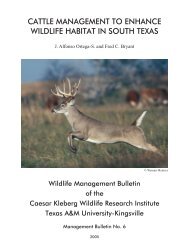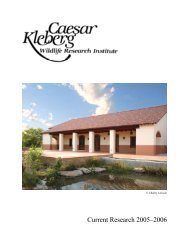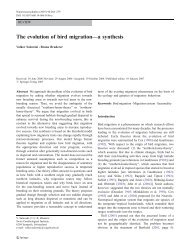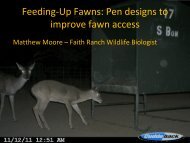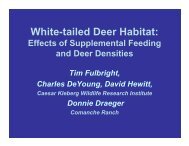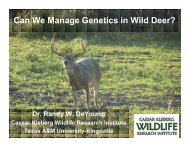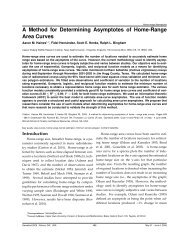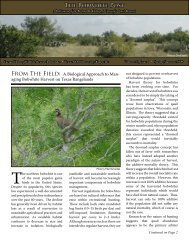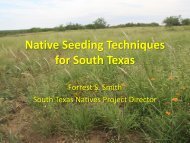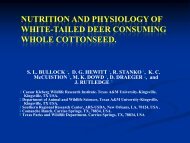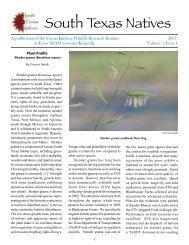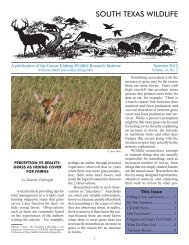The Northern Yellowstone Elk: Density Dependence and Climatic ...
The Northern Yellowstone Elk: Density Dependence and Climatic ...
The Northern Yellowstone Elk: Density Dependence and Climatic ...
Create successful ePaper yourself
Turn your PDF publications into a flip-book with our unique Google optimized e-Paper software.
J. Wildl. Manage. 66(1):2002DENSITY DEPENDENCE IN YELLOWSTONE ELK * Taper <strong>and</strong> Gogan 113Taper 1992, Stacey et al. 1997). Unfortunately,data are not available for us to verify the existenceof permanent long range movements inthis population or to determine the densitydependentnature of the process. However, lowdispersal rates for the northern <strong>Yellowstone</strong> elkherd have been documented (Houston 1982).Fertility.-Fertility often is defined as the numberof female offspring produced/female thatsurvive to the first population census or estimatefollowing birth (Keyfitz 1985, Caswell 2001).However, because the herd composition surveysdo not identify calf sex, we define fertility as thenumber of calves produced/female that surviveto the first census. Fertility is calculated as theratio of the estimated number of calves in thepopulation at the time of the next winter's compositionsurvey divided by the number of femalesestimated in the post-hunt population of the previouswinter. <strong>The</strong> composition surveys do not dis-tinguish yearling females from reproductivelymature females. Our demographic model incor-porates these data to minimize the consequencesof this constraint.Survival Rate. We define adult survival rate asthe ratio of the estimated number of adults in thepre-hunt estimate for the following year to theestimated number of adults in the post-hunt estimate.We are unable to separately estimate thesurvival of males <strong>and</strong> females; the hunt data donot completely break the kill down into males<strong>and</strong> females. Because this estimate of survivaldoes not follow marked cohorts but depends onraw population estimates, survival rate estimates>1 can <strong>and</strong> do occur.Curve Fitting.-<strong>The</strong> estimates for fertility <strong>and</strong>survival rate are plotted against population den-sity. Based on these plots, we decided on appropriatefunctional forms for recruitment <strong>and</strong> survivalrate <strong>and</strong> estimated the parameters of thesemodels using nonlinear curve fitting. We usedMarquardt's (1963) algorithm to fit the curves.Composition counts are sporadic during thelate period. As a consequence, there are only afew years during the late period where recruitment<strong>and</strong> survival rates were estimated. We baseour estimates of survival <strong>and</strong> fertility/densitydependence curves solely on data from the earlyperiod.A Simple Demographic ModelTo incorporate the nonlinearity in the northern<strong>Yellowstone</strong> elk herd population dynamics thatour initial analysis discovered, we constructed asimple demographic model of population growth.Population growth rate (rt) is modeled as:rt= n ( (N) fNt + s (Nt)Nt)Nt(1)where Nt is population size, m(Nt) is fertility, ft isproportion of females in the population at time t,<strong>and</strong> s(Nt) is survivorship.This simple formulation allows for separatedensity dependence in survivorship (s[Nt]) <strong>and</strong>in fertility (m[Nt]). <strong>The</strong> major drawback of thisapproach is that the model does not distinguishbetween yearling females <strong>and</strong> reproductivelymature females. On average, this is incorporatedin the estimate of fertility. However, some of theyear-to-year variation in observed growth rate maybe due to variation in the proportion of the populationof females in the pre-reproductive stage.We used appropriate parametric forms for survivorship(s[Nt]) <strong>and</strong> fertility (m[Nt]) derivedfrom inspection of the estimated rates. Marquardt'salgorithm had convergence problems sowe fit equation 1 with the Nelder/Mead downhillsimplex method, a very robust technique for nonlinearregression (Nelder <strong>and</strong> Mead 1965, Presset al. 1992). We also investigated nonlinearity inthe elk population dynamics, using a 0-Rickermodel (Gilpin <strong>and</strong> Ayala 1973, Thomas et al.1980, Hooten 1995)Interpolation of the Proportion of Females. <strong>The</strong>proportion of adult females in the population isa necessary parameter for predicting growth rateusing the demographic model. This informationis missing for 1992-1993 <strong>and</strong> 1993-1994. However,there is noticeable continuity in the proportion offemales in the population through time. <strong>The</strong>refore,we constructed estimates of the proportionof adult females in the population for those 2 yearsfrom surrounding data using linear interpolation.RESULTSTesting for <strong>Density</strong> <strong>Dependence</strong><strong>The</strong> 17 transitions that comprise the time seriesare divided into 4 unbroken sub-series (Table 1).<strong>The</strong> parametric bootstrap of the Dennis <strong>and</strong>Taper (1994) test was conditioned on the initialpopulation sizes for each sub-series. Despite thetime series' brevity <strong>and</strong> its division into multiplesub-series, both of which should reduce thepower of a test, a 1-sided test was significant atapproximately P = 0.009 (2-sided test P= 0.018).This justifies rejecting the a priori null hypothe-



